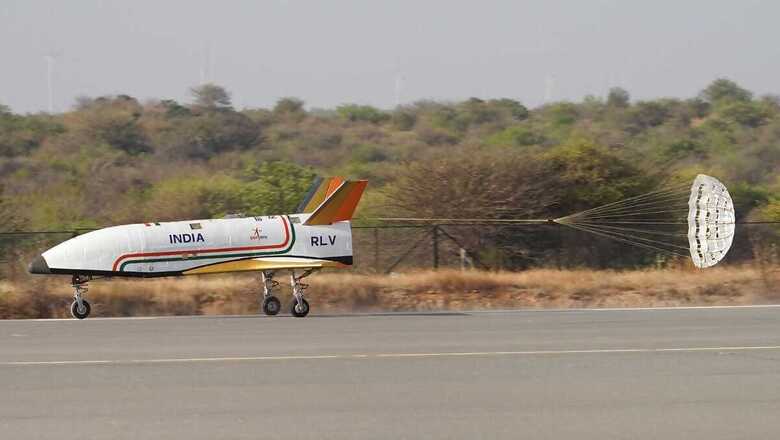
views
Just like a rocket, it will take-off from the launch pad, ascend into space, deploy the satellite into a low-earth orbit, and re-enter the earth’s atmosphere flying at a speed faster than the speed of sound. The wheels would come out from underneath allowing it to glide down to a runway landing.
Over a decade after the US-based National Aeronautics and Space Administration (NASA) retired the world’s first-ever fleet of space-shuttles, India is building its own. The aim — a reusable two-stage orbital launch vehicle which can bring down the cost of access to space.
On the morning of April 2, the Indian Space Research Organisation (ISRO) returned to the Aeronautical Test Range (ATR) in Karnataka’s Chitradurga to conduct the second major test of this Fully Reusable Launch Vehicle (RLV). RLV is like a specialised aircraft that combines complexity of both — a space rocket and an airplane. ISRO had shared the first glimpse of this prototype seven years ago, when it conducted its first flight test in May 2016 from Sriharikota.
RLV's autonomous approach and landing pic.twitter.com/D4tDmk5VN5— ISRO (@isro) April 2, 2023
SLOW AND STEADY
In 2016, the plan was not to achieve a precise landing on the runway. The launch vehicle reached an altitude of about 65 km, after which its path carried it back to earth and it splashed down in the Bay of Bengal. The experiment was conducted to evaluate the hypersonic flight that was faster than the speed of sound, navigation, and a successful re-entry of this hypersonic sub-orbital vehicle.
This April, ISRO’s focus was to achieve this Autonomous Landing on the runway. The latest experiment was essentially an air-drop test where a scaled-down version of RLV was flown as an underslung load of IAF’s Chinook Helicopter 4.5 km into the air – highest for any such winged body. It was then released in mid-air, enabling the spacecraft to manoeuvre in the air before rolling down on the ATR air strip within 30 minutes of its ascent. The landing was carried out almost exactly how an un-manned space vehicle would return to earth racing up to 350kmph.
ISRO has been steadily improving its re-usable thermal protection system that are critical to keep any earth-bound spacecraft from burning up during re-entry. In 2007, it also demonstrated its capability to recover a 555 kg orbiting space capsule which splashed down into the Bay of Bengal after re-entering the earth’s atmosphere.
SOARING SPACE AMBITIONS
ISRO’s next big mission is to send its astronauts into space and become only the fourth country in the world to do so. The maiden human spaceflight –- Gaganyaan is planned for launch in late 2025 aboard GSLV Mk-III. While the preparations are underway, ISRO is also simultaneously laying the groundwork for subsequent missions and developing technologies that it would require to sustain the human spaceflight programmes.
In June 2019, then ISRO chairman Dr K Sivan also revealed the country’s long-term plan to set up its own space station. Experts say the reusable launch vehicles may also be a step in this direction.
“It depends on what we want to do — whether we want to launch satellites into space using reusable rockets or extend human-led missions after Gaganyaan. Either way, ISRO is parallel working on other technologies that would be required in future when missions fly with astronauts on-board,” Gp Cap (retd) Ajey Lele, consultant at New Delhi-based Manohar Parrikar Institute for Defence Studies and Analyses (IDSA) tells News18.
As interest in space activities grow globally and new players come in, reusable launch vehicles could also open up new opportunities. It could help bring down the cost of launching satellites into space, dropping the per-flight cost.
LONG WAY AHEAD
NASA’s Space Shuttle Columbia was the first reusable spacecraft to travel into space in April 1981. Only three space planes have flown successfully since then — NASA’s Space Shuttles until they retired in 2011 after carrying out 135 missions, Boeing’s X-fleet spaceships (X-37B) and the Soviet’s Buran. All of them were boosted into space using a rocket.
Now, there are reports that European Space Agency (ESA) is also building its own Space Rider. China too conducted a test flight of its re-usable spacecraft.
But, ISRO is at a very preliminary stage. There is still a long way to go before ISRO’s fully-reusable two-stage spacecraft becomes a reality. But the successful flight has definitely marked an important breakthrough and the next step would be to test an orbital re-entry.
Read all the Latest India News here




















Comments
0 comment